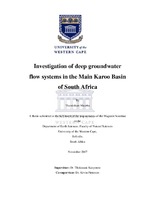| dc.contributor.advisor | Kanyerere, Thokozani | |
| dc.contributor.author | Maceba, Thandokazi | |
| dc.date.accessioned | 2018-03-22T11:02:56Z | |
| dc.date.available | 2019-04-30T22:10:04Z | |
| dc.date.issued | 2017 | |
| dc.identifier.uri | http://hdl.handle.net/11394/5829 | |
| dc.description | Magister Scientiae - MSc (Earth Science) | |
| dc.description.abstract | The improvement in hydraulic fracturing techniques resulted in the exploitation of natural gas associated with low-permeability of organic-rich shale formations in the United States. South Africa has prospective shale gas reserves associated with the marine black shales of the lower Ecca Group's Whitehill Formation in the Karoo Basin. The marine shales development in the Karoo Basin is centred on the diversifying the primary energy mix. The Karoo is a semi-arid region whose communities solely dependent on groundwater for their development. Groundwater concerns in the Karoo Basin regarding shale gas development include water resource degradation by stray gas migration and also flowback or produced water from deeper formations. The main aim of this study was to improve understanding on the risks posed by shale gas extraction on shallow aquifers in order to propose mitigation measures for groundwater protection in the main Karoo Basin. This study employed a conceptual qualitative design to understand aquifer behaviour from the informants' perspective. The perspectives in the study area were informed by two pre-existing conceptual models used as schools of thought in order to create a site specific conceptual model for the current study. Also, the study also made use of Groundwater Model Multi Criteria Analysis, a risk based assessment to explain potential subsurface risks to groundwater resources. A site specific conceptual model of local, intermediate and deep groundwater flow systems was developed based on the two models to investigate shallow and deep aquifer systems and their interactions which might lead to potential shallow aquifer contamination. The study found shallow aquifer systems exist at depths <300m, such aquifers were not locally recharged, but recharged by hilltops containing large number of vertical fractures. These aquifer systems are associated with dolerite intrusion. Due to thermal effects, dykes caused fracturing of adjacent rocks such as sandstone/ mudstone significant increase in yields of adjacent boreholes. The intermediate aquifer systems are mostly associated with fractures, with deep burial fracture systems with fault systems. These systems are normally expressed to the surface as springs to an order of 100-1000 meters. These saline aquifer systems are poorly understood and unknown if they are widespread. | |
| dc.language.iso | en | |
| dc.publisher | University of the Western Cape | |
| dc.title | Investigation of deep groundwater flow systems in the Main Karoo Basin of South Africa | |
| dc.rights.holder | University of the Western Cape | |

